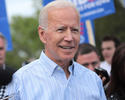California’s coastal urban centers, once the ultimate land of opportunity, suffer notorious traffic congestion, unaffordable housing, and a social chasm defined by a shrinking middle class, a small wealthy sector, and a sizable population seemingly locked in poverty. read more »
Demographics
Strong Communities Need Public Spaces — and Private Enterprise
We need parks and libraries and town squares for gathering. We also need shops, restaurants, and other commercial amenities. read more »
Blaming the Gipper
Political progressives have an opening to rewrite recent U.S. history, and they don’t intend to stop with the Trump years. The deepest left has already gone way back (as far as the celebrated 1619 Project), but for most social welfare Democrats, it’s enough to erase the stain of Ronald Reagan. read more »
- Login to post comments
If Biden Can't Build a Better Economy, America is In Trouble
Donald Trump’s finally gone, but if Joe Biden wants his return to normalcy to be any more successful than his predecessor’s appeal to greatness, he’ll need to take on the real issues dragging red and blue America down: economic torpor, ever increasing inequality, and policies that diminish people’s prospects of making it into or maintaining their positions in the middle class. read more »
- Login to post comments
Woke Politics Are a Disaster for Minorities
Bill Clinton may have been lionized as the “first black President,” and Barack Obama actually was half African, but no politician in American history owes more to African-American leadership and voters than Joe Biden. His campaign never smoldered, much less caught fire, until he was embraced by South Carolina’s heavily black Democratic electorate. read more »
- Login to post comments
‘Call Your Mother’ Sitcom Is Coastally Out of Step
Call Your Mother is lame enough as it is. But a major extra shortcoming of ABC’s latest sitcom, which recently debuted with a pilot episode, is that one of its foundations is a banal juxtaposition of Flyover Country with the coasts.
Get this: A central premise of the show is that an empty-nester widow moves to Los Angeles from Iowa to be near her two adult kids who like living in California right now. In that important regard, Call Your Mother is so, well, 2019 – and so heedless of the current zeitgeist.
read more »- Login to post comments
Quality Of Life, Or Quantity Of Lives?
Anyone who's been in the urbanism game as long as I have (or longer) is probably familiar with the annual Places Rated Almanac, the annual metro area ranking reference produced by David Savageau. First published in 1981, I remember seeing each year's edition in bookstores while I was in high school and college, and it was the first attempt I could remember at evaluating the positives and negatives of place, and ranking them accordingly. read more »
- Login to post comments
Progressives Must Stop Celebrating Urban Flight
As the nation enters 2021 with hopes of healing divisions, Vox published a story with the drop headline, “Young families and wealthy people are decamping for the suburbs — which might make cities more pleasant for everyone else.” This is exactly the continued nonsense from the left that continues to polarize our discourse, and it needs to stop. read more »
- Login to post comments
2020 Metro Virus Fatality Rates & Observations
This article provides data on COVID-19 fatality rates for the 53 US major metropolitan areas, from the first infection to December 31, 2020.Because so many US major metropolitan areas (over 1,000,000 population) stretch across state lines, the article indicates all of the states each is located in (for example, Philadelphia is in four states, Pennsylvania, New Jersey, Delaware and Maryland). read more »
- Login to post comments
A New Localism Can Heal, Advance Flyover Country
The mess in Washington underscores the harsh reality that our national fissures aren't going to be healed any time soon – if ever. Among other things, that means America will have to progress on the local and regional levels, where people actually live, whatever happens on the fractured plane of national identity and politics.
Call it a new localism. read more »
- Login to post comments






















